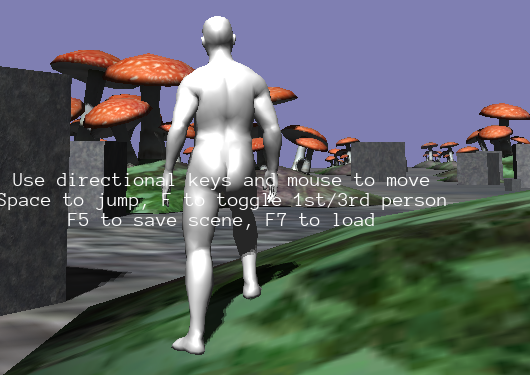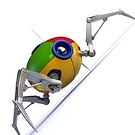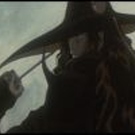I’ve done a few updates/fixes, set as a component and ported to AngelScript (as I almost don’t use lua anymore).
It’s still far from perfect as it requires some manual settings (like ‘lerp’, ‘doIK’…) and an AnimationController (and I haven’t tested how it behaves without physics).
Also I haven’t found a convenient way to check if the AnimationController is playing something or not.
[spoiler]class FootIK : ScriptObject
{
String leftFootName = “”;
String rightFootName = “”;
Vector3 legAxis;
float unevenThreshold = 0.05; // Set this threshold according to the delta between feet height in idle position/animation
bool doIK = true; // Allow to disable Foot IK, which is only relevant when the character is grounded
Node@ leftFoot;
Node@ rightFoot;
Node@ rootBone;
float leftLegLength = 0;
float rightLegLength = 0;
float originalRootHeight = 0;
Quaternion leftFootInitialRot;
Quaternion rightFootInitialRot;
void CreateIKChains()
{
// Set IK chains effectors
leftFoot = node.GetChild(leftFootName, true);
rightFoot = node.GetChild(rightFootName, true);
if (leftFoot is null || rightFoot is null)
{
log.Info
("Cannot get feet nodes " + leftFootName + " and/or " + rightFootName);
return;
}
if (leftFoot.parent is null || leftFoot.parent.parent is null || rightFoot.parent is null || rightFoot.parent.parent is null)
return;
// Set variables
AnimatedModel@ model = node.GetComponent("AnimatedModel");
Skeleton@ skel = model.skeleton;
if (skel is null) return;
rootBone = node.GetChild(skel.rootBone.name, true); // Get root bone of the skeleton as we will move its node up/down to match IK targets
leftLegLength = skel.GetBone(leftFoot.parent.parent.name).boundingBox.size.y + skel.GetBone(leftFoot.parent.name).boundingBox.size.y; // Left thigh length + left calf length
rightLegLength = skel.GetBone(rightFoot.parent.parent.name).boundingBox.size.y + skel.GetBone(rightFoot.parent.name).boundingBox.size.y; // Right thigh length + right calf length
originalRootHeight = rootBone.worldPosition.y - node.position.y; // Used when no animation is playing
// Keep track of initial rotation in case no animation is playing
leftFootInitialRot = skel.GetBone(leftFootName).initialRotation;
rightFootInitialRot = skel.GetBone(rightFootName).initialRotation;
// Subscribe to the SceneDrawableUpdateFinished event which is triggered after the animations have been updated, so we can apply IK to override them
SubscribeToEvent("SceneDrawableUpdateFinished", "HandleSceneDrawableUpdateFinished");
}
void HandleSceneDrawableUpdateFinished(StringHash eventType, VariantMap& eventData)
{
if (doIK) SolveLegIK(eventData[“TimeStep”].GetFloat());
}
void SolveIKUrho(Node@ effectorNode, Vector3 targetPos)
{
// Get current world position for the 3 joints of the IK chain
Vector3 startJointPos = effectorNode.parent.parent.worldPosition; // Thigh pos (hip joint)
Vector3 midJointPos = effectorNode.parent.worldPosition; // Calf pos (knee joint)
Vector3 effectorPos = effectorNode.worldPosition; // Foot pos (ankle joint)
// Direction vectors
Vector3 thighDir = midJointPos - startJointPos; // Thigh direction
Vector3 calfDir = effectorPos - midJointPos; // Calf direction
Vector3 targetDir = targetPos - startJointPos; // Leg direction
// Vectors lengths
float length1 = thighDir.length;
float length2 = calfDir.length;
float limbLength = length1 + length2;
float lengthH = targetDir.length;
if (lengthH > limbLength)
{
targetDir = targetDir * (limbLength / lengthH) * 0.999; // Do not overshoot if target unreachable
lengthH = targetDir.length;
}
float lengthHsquared = targetDir.lengthSquared;
// Current knee angle (from animation keyframe)
float kneeAngle = thighDir.Angle(calfDir);
// New knee angle
float cos_theta = (lengthHsquared - thighDir.lengthSquared - calfDir.lengthSquared) / (2 * length1 * length2);
if (cos_theta > 1) cos_theta = 1; else if (cos_theta < -1) cos_theta = -1;
float theta = Acos(cos_theta);
// Quaternions for knee and hip joints
if (Abs(theta - kneeAngle) > 0.01)
{
Quaternion deltaKnee = Quaternion((theta - kneeAngle), legAxis);
Quaternion deltaHip = Quaternion(-(theta - kneeAngle) * 0.5, legAxis);
// Apply rotations
effectorNode.parent.rotation = effectorNode.parent.rotation * deltaKnee;
effectorNode.parent.parent.rotation = effectorNode.parent.parent.rotation * deltaHip;
}
}
void SolveLegIK(float timeStep)
{
// ONLY IF NO ANIMATION playing: reset rootBone height
AnimationController@ animCtrl = node.GetComponent(“AnimationController”);
if (
node.name
== “Jack” && !animCtrl.IsPlaying(“Models/Jack_Walk.ani”))
rootBone.worldPosition = Vector3(rootBone.worldPosition.x, node.position.y + originalRootHeight, rootBone.worldPosition.z);
// Root bone and feet height from animation keyframe and character node position
float footHeightL = leftFoot.worldPosition.y - node.position.y;
float footHeightR = rightFoot.worldPosition.y - node.position.y;
// Current feet position from animation keyframe
Vector3 leftGround = leftFoot.worldPosition;
Vector3 rightGround = rightFoot.worldPosition;
Octree@ octree = scene.octree;
float leftHeightDiff = 0; // Distance from left foot to ground, while preserving animation's foot offset from ground
float rightHeightDiff = 0; // Distance from right foot to ground, while preserving animation's foot offset from ground
Vector3 leftNormal = Vector3(0, 0, 0);
Vector3 rightNormal = Vector3(0, 0, 0);
// Left Foot (NB: ray cast is performed from a position above the foot, but not higher than the character so that we get an accurate result when foot is currently underground)
RayQueryResult result = octree.RaycastSingle(Ray(leftGround + Vector3(0, leftLegLength, 0), Vector3(0, -1, 0)), RAY_TRIANGLE, 10, DRAWABLE_GEOMETRY, 63); // NB: skip last 2 view mask layers that contain self, foot effects, cutouts...
if (result.drawable !is null)
{
leftGround = result.position;
leftHeightDiff = leftFoot.worldPosition.y - (leftGround.y + footHeightL); // Distance from foot to ground, while preserving animation's foot offset from ground
leftNormal = result.normal; // Used to make foot to face along the ground normal
}
// Right Foot (NB: ray cast is performed from a position above the foot, but not higher than the character so that we get an accurate result when foot is currently underground)
RayQueryResult result2 = octree.RaycastSingle(Ray(rightGround + Vector3(0, rightLegLength, 0), Vector3(0, -1, 0)), RAY_TRIANGLE, 10, DRAWABLE_GEOMETRY, 63); // NB: skip last 2 view mask layers that contain self, foot effects, cutouts...
if (result2.drawable !is null)
{
rightGround = result2.position;
rightHeightDiff = rightFoot.worldPosition.y - (rightGround.y + footHeightR); // Distance from foot to ground, while preserving animation's foot offset from ground
rightNormal = result2.normal; // Used to make foot to face along the ground normal
}
// Feet are facing ground normal
if (node.name == "Jack" && !animCtrl.IsPlaying("Models/Jack_Walk.ani")) // When no animation is playing, manually reset rotation (when an animation is playing, rotation is reset by the keyframe)
{
leftFoot.rotation = leftFootInitialRot;
rightFoot.rotation = rightFootInitialRot;
}
leftFoot.worldRotation = Quaternion(Vector3(0, 1, 0), leftNormal) * leftFoot.worldRotation;
rightFoot.worldRotation = Quaternion(Vector3(0, 1, 0), rightNormal) * rightFoot.worldRotation;
// Skip grounding if flat ground
if(Abs(rightHeightDiff - leftHeightDiff) < 0.001) return;
// From animation keyframe, determine which foot should be grounded
bool leftDown = false;
bool rightDown = false;
if (leftGround.y < rightGround.y - unevenThreshold) leftDown = true;
else if (rightGround.y < leftGround.y - unevenThreshold) rightDown = true;
// If feet are at even level in animation, ground at lowest ray cast level
if (!leftDown && !rightDown)
{
if (leftGround.y < rightGround.y) leftDown = true; else rightDown = true;
}
// Set root bone offset to reach grounded foot target position. Also update non grounded foot from this offset
float heightDiff = 0;
if (leftDown)
{
heightDiff = leftHeightDiff;
rightGround = rightGround + Vector3(0, heightDiff, 0);
}
else if (rightDown)
{
heightDiff = rightHeightDiff;
leftGround = leftGround + Vector3(0, heightDiff, 0);
}
// Move the root bone (NB: node has already been 'moved' by its physics collider)
rootBone.worldPosition = rootBone.worldPosition - Vector3(0, heightDiff, 0);
// Selectively solve IK
if (!leftDown) SolveIKUrho(leftFoot, leftGround);
if (!rightDown) SolveIKUrho(rightFoot, rightGround);
}
}[/spoiler]
[spoiler]
#include
“Scripts/Utilities/Sample.as”
#include
“Scripts/Utilities/Touch.as”
#include
“Scripts/Perso/Foot_IK.as”
const int CTRL_FORWARD = 1;
const int CTRL_BACK = 2;
const int CTRL_LEFT = 4;
const int CTRL_RIGHT = 8;
const int CTRL_JUMP = 16;
const float MOVE_FORCE = 0.8f;
const float INAIR_MOVE_FORCE = 0.02f;
const float BRAKE_FORCE = 0.2f;
const float JUMP_FORCE = 7.0f;
const float YAW_SENSITIVITY = 0.1f;
const float INAIR_THRESHOLD_TIME = 0.1f;
bool firstPerson = false; // First person camera flag
Node@ characterNode;
String characterName = “Jack”; // Character to create, from “Jack”, “Ninja” or a prefab character
void Start()
{
SampleStart(); // Execute the common startup for samples
CreateScene(); // Create static scene content
// Create the controllable character
if (characterName == "Jack") CreateJack();
else if (characterName == "Ninja") CreateNinja();
else CreateCharacter(characterName);
CreateInstructions(); // Create the UI content
SubscribeToEvents(); // Subscribe to necessary events
}
void CreateScene()
{
scene_ = Scene();
// Create scene subsystem components
scene_.CreateComponent("Octree");
scene_.CreateComponent("PhysicsWorld");
scene_.CreateComponent("DebugRenderer");
// Create camera and define viewport. Camera does not necessarily have to belong to the scene
cameraNode = Node();
Camera@ camera = cameraNode.CreateComponent("Camera");
camera.farClip = 300.0f;
renderer.viewports[0] = Viewport(scene_, camera);
// Create a Zone component for ambient lighting & fog control
Node@ zoneNode = scene_.CreateChild("Zone");
Zone@ zone = zoneNode.CreateComponent("Zone");
zone.boundingBox = BoundingBox(-1000.0f, 1000.0f);
zone.ambientColor = Color(0.15f, 0.15f, 0.15f);
zone.fogColor = Color(0.5f, 0.5f, 0.7f);
zone.fogStart = 100.0f;
zone.fogEnd = 300.0f;
// Create a directional light to the world. Enable cascaded shadows on it
Node@ lightNode = scene_.CreateChild("DirectionalLight");
lightNode.direction = Vector3(0.6f, -1.0f, 0.8f);
Light@ light = lightNode.CreateComponent("Light");
light.lightType = LIGHT_DIRECTIONAL;
light.castShadows = true;
light.shadowBias = BiasParameters(0.00025f, 0.5f);
// Set cascade splits at 10, 50 and 200 world units, fade shadows out at 80% of maximum shadow distance
light.shadowCascade = CascadeParameters(10.0f, 50.0f, 200.0f, 0.0f, 0.8f);
// Create the floor object
Node@ floorNode = scene_.CreateChild("Floor");
floorNode.position = Vector3(0.0f, -0.5f, 0.0f);
floorNode.scale = Vector3(200.0f, 1.0f, 200.0f);
StaticModel@ object = floorNode.CreateComponent("StaticModel");
object.model = cache.GetResource("Model", "Models/Box.mdl");
object.material = cache.GetResource("Material", "Materials/Stone.xml");
RigidBody@ body = floorNode.CreateComponent("RigidBody");
// Use collision layer bit 2 to mark world scenery. This is what we will raycast against to prevent camera from going inside geometry
body.collisionLayer = 2;
CollisionShape@ shape = floorNode.CreateComponent("CollisionShape");
shape.SetBox(Vector3(1.0f, 1.0f, 1.0f));
// Create mushrooms of varying sizes
const uint NUM_MUSHROOMS = 60;
for (uint i = 0; i < NUM_MUSHROOMS; ++i)
{
Node@ objectNode = scene_.CreateChild("Mushroom");
objectNode.position = Vector3(Random(180.0f) - 90.0f, 0.0f, Random(180.0f) - 90.0f);
objectNode.rotation = Quaternion(0.0f, Random(360.0f), 0.0f);
objectNode.SetScale(2.0f + Random(5.0f));
StaticModel@ object = objectNode.CreateComponent("StaticModel");
object.model = cache.GetResource("Model", "Models/Mushroom.mdl");
object.material = cache.GetResource("Material", "Materials/Mushroom.xml");
object.castShadows = true;
RigidBody@ body = objectNode.CreateComponent("RigidBody");
body.collisionLayer = 2;
CollisionShape@ shape = objectNode.CreateComponent("CollisionShape");
shape.SetTriangleMesh(object.model, 0);
}
// Create movable boxes. Let them fall from the sky at first
const uint NUM_BOXES = 100;
for (uint i = 0; i < NUM_BOXES; ++i)
{
float scale = Random(2.0f) + 0.5f;
Node@ objectNode = scene_.CreateChild("Box");
objectNode.position = Vector3(Random(180.0f) - 90.0f, Random(10.0f) + 10.0f, Random(180.0f) - 90.0f);
objectNode.rotation = Quaternion(Random(360.0f), Random(360.0f), Random(360.0f));
objectNode.SetScale(scale);
StaticModel@ object = objectNode.CreateComponent("StaticModel");
object.model = cache.GetResource("Model", "Models/Box.mdl");
object.material = cache.GetResource("Material", "Materials/Stone.xml");
object.castShadows = true;
RigidBody@ body = objectNode.CreateComponent("RigidBody");
body.collisionLayer = 2;
// Bigger boxes will be heavier and harder to move
body.mass = scale * 2.0f;
CollisionShape@ shape = objectNode.CreateComponent("CollisionShape");
shape.SetBox(Vector3(1.0f, 1.0f, 1.0f));
}
// STEEP
Node@ slope = scene_.CreateChild("Slope");
slope.scale = Vector3(10, 1, 5);
slope.position = Vector3(0, 1.5, 5);
slope.rotation = Quaternion(0, -90, 25);
StaticModel@ model = slope.CreateComponent("StaticModel");
model.model = cache.GetResource("Model", "Models/Box.mdl");
model.material = cache.GetResource("Material", "Materials/Stone.xml");
RigidBody@ steepBody = slope.CreateComponent("RigidBody");
steepBody.collisionLayer = 2;
CollisionShape@ steepShape = slope.CreateComponent("CollisionShape");
steepShape.SetBox(Vector3(1, 1, 1));
}
void CreateJack()
{
characterNode = scene_.CreateChild(“Jack”);
// Create the rendering component + animation controller
AnimatedModel@ object = characterNode.CreateComponent("AnimatedModel");
object.model = cache.GetResource("Model", "Models/Jack.mdl");
object.material = cache.GetResource("Material", "Materials/Jack.xml");
object.castShadows = true;
characterNode.CreateComponent("AnimationController");
object.viewMask = 64; // Enable layer 7 only, to skip when raycasting the octree
// Create rigidbody, and set non-zero mass so that the body becomes dynamic
RigidBody@ body = characterNode.CreateComponent("RigidBody");
body.collisionLayer = 1;
body.mass = 1;
// Set zero angular factor so that physics doesn't turn the character on its own.
// Instead we will control the character yaw manually
body.angularFactor = Vector3(0, 0, 0);
// Set the rigidbody to signal collision also when in rest, so that we get ground collisions properly
body.collisionEventMode = COLLISION_ALWAYS;
// Set a capsule shape for collision
CollisionShape@ shape = characterNode.CreateComponent("CollisionShape");
shape.SetCapsule(0.6, 1.8, Vector3(0, 0.9, 0));
// Create the character logic object, which takes care of steering the rigidbody
characterNode.CreateScriptObject(scriptFile, "Character");
// Create a foot IK script object
FootIK@ footIK = cast<FootIK>(characterNode.CreateScriptObject(scriptFile, "FootIK"));
footIK.leftFootName = "Bip01_L_Foot";
footIK.rightFootName = "Bip01_R_Foot";
footIK.legAxis = Vector3(0, 0, -1);
footIK.CreateIKChains();
}
void CreateCharacter(String name)
{
characterNode = scene_.InstantiateXML(cache.GetFile(“Assets/” + name + “/Objects/” + name + “.xml”), Vector3(0, 0, 0), Quaternion(0, 0, 0));
characterNode.CreateComponent(“AnimationController”);
characterNode.CreateScriptObject(scriptFile, “Character”);
AnimatedModel@ model = characterNode.GetComponent(“AnimatedModel”);
model.viewMask = 64; // Enable layer 7 only, to skip when raycasting the octree
// Create a foot IK script object
FootIK@ footIK = cast<FootIK>(characterNode.CreateScriptObject(scriptFile, "FootIK"));
footIK.leftFootName = "Foot.L";
footIK.rightFootName = "Foot.R";
footIK.legAxis = Vector3(-1, 0, 0);
footIK.CreateIKChains();
}
void CreateNinja()
{
characterNode = scene_.CreateChild(“Ninja”);
// Create the rendering component + animation controller
AnimatedModel@ object = characterNode.CreateComponent("AnimatedModel");
object.model = cache.GetResource("Model", "Models/NinjaSnowWar/Ninja.mdl");
object.material = cache.GetResource("Material", "Materials/NinjaSnowWar/Ninja.xml");
object.castShadows = true;
characterNode.CreateComponent("AnimationController");
object.viewMask = 64; // Enable layer 7 only, to skip when raycasting the octree
// Create rigidbody, and set non-zero mass so that the body becomes dynamic
RigidBody@ body = characterNode.CreateComponent("RigidBody");
body.collisionLayer = 1;
body.mass = 1;
// Set zero angular factor so that physics doesn't turn the character on its own.
// Instead we will control the character yaw manually
body.angularFactor = Vector3(0, 0, 0);
// Set the rigidbody to signal collision also when in rest, so that we get ground collisions properly
body.collisionEventMode = COLLISION_ALWAYS;
// Set a capsule shape for collision
CollisionShape@ shape = characterNode.CreateComponent("CollisionShape");
shape.SetCapsule(0.5, 1.8, Vector3(0, 0.9, 0));
// Create the character logic object, which takes care of steering the rigidbody
characterNode.CreateScriptObject(scriptFile, "Character");
// Create a foot IK script object
FootIK@ footIK = cast<FootIK>(characterNode.CreateScriptObject(scriptFile, "FootIK"));
footIK.leftFootName = "Joint20";
footIK.rightFootName = "Joint25";
footIK.legAxis = Vector3(1, 0, 0);
footIK.CreateIKChains();
}
void CreateInstructions()
{
// Construct new Text object, set string to display and font to use
Text@ instructionText = ui.root.CreateChild(“Text”, “Instructions”);
instructionText.text = “Use WASD keys and mouse to move\n” “Space to jump, F to toggle 1st/3rd person\n” “F5 to save scene, F7 to load”;
instructionText.SetFont(cache.GetResource(“Font”, “Fonts/Anonymous Pro.ttf”), 15);
// The text has multiple rows. Center them in relation to each other
instructionText.textAlignment = HA_CENTER;
// Position the text relative to the screen center
instructionText.horizontalAlignment = HA_CENTER;
instructionText.verticalAlignment = VA_CENTER;
instructionText.SetPosition(0, ui.root.height / 4);
}
void SubscribeToEvents()
{
SubscribeToEvent(“Update”, “HandleUpdate”); // Subscribe to Update event for setting the character controls before physics simulation
SubscribeToEvent(“PostUpdate”, “HandlePostUpdate”); // Subscribe to PostUpdate event for updating the camera position after physics simulation
UnsubscribeFromEvent(“SceneUpdate”); // Unsubscribe the SceneUpdate event from base class as the camera node is being controlled in HandlePostUpdate() in this sample
SubscribeToEvent(“PostRenderUpdate”, “HandlePostRenderUpdate”); // Process post-render update event, during which we request debug geometry
}
void HandleUpdate(StringHash eventType, VariantMap& eventData)
{
if (characterNode is null)
return;
Character@ character = cast<Character>(characterNode.scriptObject);
if (character is null)
return;
// Clear previous controls
character.controls.Set(CTRL_FORWARD | CTRL_BACK | CTRL_LEFT | CTRL_RIGHT | CTRL_JUMP, false);
// Update controls using touch utility
if (touchEnabled)
UpdateTouches(character.controls);
// Update controls using keys (desktop)
if (ui.focusElement is null)
{
if (touchEnabled || !useGyroscope)
{
character.controls.Set(CTRL_FORWARD, input.keyDown[KEY_UP]);
character.controls.Set(CTRL_BACK, input.keyDown[KEY_DOWN]);
character.controls.Set(CTRL_LEFT, input.keyDown[KEY_LEFT]);
character.controls.Set(CTRL_RIGHT, input.keyDown[KEY_RIGHT]);
}
character.controls.Set(CTRL_JUMP, input.keyDown[KEY_SPACE]);
// Add character yaw & pitch from the mouse motion or touch input
if (touchEnabled)
{
for (uint i = 0; i < input.numTouches; ++i)
{
TouchState@ state = input.touches[i];
if (state.touchedElement is null) // Touch on empty space
{
Camera@ camera = cameraNode.GetComponent("Camera");
if (camera is null)
return;
character.controls.yaw += TOUCH_SENSITIVITY * camera.fov / graphics.height * state.delta.x;
character.controls.pitch += TOUCH_SENSITIVITY * camera.fov / graphics.height * state.delta.y;
}
}
}
else
{
character.controls.yaw += input.mouseMoveX * YAW_SENSITIVITY;
character.controls.pitch += input.mouseMoveY * YAW_SENSITIVITY;
}
// Limit pitch
character.controls.pitch = Clamp(character.controls.pitch, -80.0f, 80.0f);
// Switch between 1st and 3rd person
if (input.keyPress['F'])
firstPerson = !firstPerson;
// Turn on/off gyroscope on mobile platform
if (input.keyPress['G'])
useGyroscope = !useGyroscope;
// Check for loading / saving the scene
if (input.keyPress[KEY_F5])
{
File saveFile(fileSystem.programDir + "Data/Scenes/CharacterDemo.xml", FILE_WRITE);
scene_.SaveXML(saveFile);
}
if (input.keyPress[KEY_F7])
{
File loadFile(fileSystem.programDir + "Data/Scenes/CharacterDemo.xml", FILE_READ);
scene_.LoadXML(loadFile);
// After loading we have to reacquire the character scene node, as it has been recreated
// Simply find by name as there's only one of them
characterNode = scene_.GetChild("Jack", true);
if (characterNode is null)
return;
}
}
// Set rotation already here so that it's updated every rendering frame instead of every physics frame
characterNode.rotation = Quaternion(character.controls.yaw, Vector3(0.0f, 1.0f, 0.0f));
// Toggle debug geometry with 'Z'
if (input.keyPress[KEY_Z]) drawDebug = !drawDebug;
}
void HandlePostRenderUpdate(StringHash eventType, VariantMap& eventData)
{
if (drawDebug) scene_.physicsWorld.DrawDebugGeometry(true); // Draw physics debug geometry. Use depth test to make the result easier to interpret
}
void HandlePostUpdate(StringHash eventType, VariantMap& eventData)
{
if (characterNode is null)
return;
Character@ character = cast<Character>(characterNode.scriptObject);
if (character is null)
return;
// Get camera lookat dir from character yaw + pitch
Quaternion rot = characterNode.rotation;
Quaternion dir = rot * Quaternion(character.controls.pitch, Vector3(1.0f, 0.0f, 0.0f));
// Third person camera: position behind the character
Vector3 aimPoint = characterNode.position + rot * Vector3(0.0f, 1.7f, 0.0f); // You can modify x Vector3 value to translate the fixed character position (indicative range[-2;2])
// Collide camera ray with static physics objects (layer bitmask 2) to ensure we see the character properly
Vector3 rayDir = dir * Vector3(0.0f, 0.0f, -1.0f); // For indoor scenes you can use dir * Vector3(0.0, 0.0, -0.5) to prevent camera from crossing the walls
float rayDistance = cameraDistance;
PhysicsRaycastResult result = scene_.physicsWorld.RaycastSingle(Ray(aimPoint, rayDir), rayDistance, 2);
if (result.body !is null)
rayDistance = Min(rayDistance, result.distance);
rayDistance = Clamp(rayDistance, CAMERA_MIN_DIST, cameraDistance);
cameraNode.position = aimPoint + rayDir * rayDistance;
cameraNode.rotation = dir;
}
// Character script object class
//
// Those public member variables that can be expressed with a Variant and do not begin with an underscore are automatically
// loaded / saved as attributes of the ScriptInstance component. We also have variables which can not be automatically saved
// (yaw and pitch inside the Controls object) so we write manual binary format load / save methods for them. These functions
// will be called by ScriptInstance when the script object is being loaded or saved.
class Character : ScriptObject
{
// Character controls.
Controls controls;
// Grounded flag for movement.
bool onGround = false;
// Jump flag.
bool okToJump = true;
// In air timer. Due to possible physics inaccuracy, character can be off ground for max. 1/10 second and still be allowed to move.
float inAirTimer = 0.0f;
void Start()
{
SubscribeToEvent(node, "NodeCollision", "HandleNodeCollision");
}
void Load(Deserializer& deserializer)
{
controls.yaw = deserializer.ReadFloat();
controls.pitch = deserializer.ReadFloat();
}
void Save(Serializer& serializer)
{
serializer.WriteFloat(controls.yaw);
serializer.WriteFloat(controls.pitch);
}
void HandleNodeCollision(StringHash eventType, VariantMap& eventData)
{
VectorBuffer contacts = eventData["Contacts"].GetBuffer();
while (!contacts.eof)
{
Vector3 contactPosition = contacts.ReadVector3();
Vector3 contactNormal = contacts.ReadVector3();
float contactDistance = contacts.ReadFloat();
float contactImpulse = contacts.ReadFloat();
// If contact is below node center and mostly vertical, assume it's a ground contact
if (contactPosition.y < (node.position.y + 1.0f))
{
float level = Abs(contactNormal.y);
if (level > 0.75)
onGround = true;
}
}
}
void FixedUpdate(float timeStep)
{
/// \todo Could cache the components for faster access instead of finding them each frame
RigidBody@ body = node.GetComponent("RigidBody");
AnimationController@ animCtrl = node.GetComponent("AnimationController");
FootIK@ footIK = cast<FootIK>(characterNode.GetScriptObject("FootIK"));
// Update the in air timer. Reset if grounded
if (!onGround)
inAirTimer += timeStep;
else
inAirTimer = 0.0f;
// When character has been in air less than 1/10 second, it's still interpreted as being on ground
bool softGrounded = inAirTimer < INAIR_THRESHOLD_TIME;
// Update movement & animation
Quaternion rot = node.rotation;
Vector3 moveDir(0.0f, 0.0f, 0.0f);
Vector3 velocity = body.linearVelocity;
// Velocity on the XZ plane
Vector3 planeVelocity(velocity.x, 0.0f, velocity.z);
if (controls.IsDown(CTRL_FORWARD))
moveDir += Vector3(0.0f, 0.0f, 1.0f);
if (controls.IsDown(CTRL_BACK))
moveDir += Vector3(0.0f, 0.0f, -1.0f);
if (controls.IsDown(CTRL_LEFT))
moveDir += Vector3(-1.0f, 0.0f, 0.0f);
if (controls.IsDown(CTRL_RIGHT))
moveDir += Vector3(1.0f, 0.0f, 0.0f);
// Normalize move vector so that diagonal strafing is not faster
if (moveDir.lengthSquared > 0.0f)
moveDir.Normalize();
// If in air, allow control, but slower than when on ground
body.ApplyImpulse(rot * moveDir * (softGrounded ? MOVE_FORCE : INAIR_MOVE_FORCE));
if (softGrounded)
{
// When on ground, apply a braking force to limit maximum ground velocity
Vector3 brakeForce = -planeVelocity * BRAKE_FORCE;
body.ApplyImpulse(brakeForce);
// Jump. Must release jump control inbetween jumps
if (controls.IsDown(CTRL_JUMP))
{
if (okToJump)
{
body.ApplyImpulse(Vector3(0.0f, 1.0f, 0.0f) * JUMP_FORCE);
okToJump = false;
}
}
else
okToJump = true;
}
// Play walk animation if moving on ground, otherwise fade it out
if (softGrounded && !moveDir.Equals(Vector3(0, 0, 0)))
{
if (characterName == "Jack") animCtrl.PlayExclusive("Models/Jack_Walk.ani", 0, true, 0.2);
else if (characterName == "Ninja") animCtrl.PlayExclusive("Models/NinjaSnowWar/Ninja_Walk.ani", 0, true, 0.2);
else animCtrl.PlayExclusive("Assets/" + characterName + "/Models/Run.ani", 0, true, 0.2);
}
else
{
if (characterName == "Jack") animCtrl.Stop("Models/Jack_Walk.ani", 0.2);
else if (characterName == "Ninja") animCtrl.PlayExclusive("Models/NinjaSnowWar/Ninja_Idle2.ani", 0, true, 0.2);
else animCtrl.PlayExclusive("Assets/" + characterName + "/Models/Idle.ani", 0, true, 0.2);
}
// Set walk animation speed proportional to velocity
animCtrl.SetSpeed("Models/Jack_Walk.ani", planeVelocity.length * 0.3f);
animCtrl.SetSpeed("Models/NinjaSnowWar/Ninja_Walk.ani", planeVelocity.length * 0.3f);
animCtrl.SetSpeed("Assets/" + characterName + "/Models/Run.ani", planeVelocity.length * 0.3);
// Set IK state (we will apply foot IK only when grounded!)
footIK.doIK = onGround;
// Reset grounded flag for next frame
onGround = false;
}
}
// Create XML patch instructions for screen joystick layout specific to this sample app
String patchInstructions =
"" +
" <add sel="/element">" +
" <element type=“Button”>" +
" <attribute name=“Name” value=“Button3” />" +
" <attribute name=“Position” value="-120 -120" />" +
" <attribute name=“Size” value=“96 96” />" +
" <attribute name=“Horiz Alignment” value=“Right” />" +
" <attribute name=“Vert Alignment” value=“Bottom” />" +
" <attribute name=“Texture” value=“Texture2D;Textures/TouchInput.png” />" +
" <attribute name=“Image Rect” value=“96 0 192 96” />" +
" <attribute name=“Hover Image Offset” value=“0 0” />" +
" <attribute name=“Pressed Image Offset” value=“0 0” />" +
" <element type=“Text”>" +
" <attribute name=“Name” value=“Label” />" +
" <attribute name=“Horiz Alignment” value=“Center” />" +
" <attribute name=“Vert Alignment” value=“Center” />" +
" <attribute name=“Color” value=“0 0 0 1” />" +
" <attribute name=“Text” value=“Gyroscope” />" +
" " +
" <element type=“Text”>" +
" <attribute name=“Name” value=“KeyBinding” />" +
" <attribute name=“Text” value=“G” />" +
" " +
" " +
" " +
" <remove sel="/element/element[./attribute[@name=‘Name’ and @value=‘Button0’]]/attribute[@name=‘Is Visible’]" />" +
" <replace sel="/element/element[./attribute[@name=‘Name’ and @value=‘Button0’]]/element[./attribute[@name=‘Name’ and @value=‘Label’]]/attribute[@name=‘Text’]/
@value
">1st/3rd" +
" <add sel="/element/element[./attribute[@name=‘Name’ and @value=‘Button0’]]">" +
" <element type=“Text”>" +
" <attribute name=“Name” value=“KeyBinding” />" +
" <attribute name=“Text” value=“F” />" +
" " +
" " +
" <remove sel="/element/element[./attribute[@name=‘Name’ and @value=‘Button1’]]/attribute[@name=‘Is Visible’]" />" +
" <replace sel="/element/element[./attribute[@name=‘Name’ and @value=‘Button1’]]/element[./attribute[@name=‘Name’ and @value=‘Label’]]/attribute[@name=‘Text’]/
@value
">Jump" +
" <add sel="/element/element[./attribute[@name=‘Name’ and @value=‘Button1’]]">" +
" <element type=“Text”>" +
" <attribute name=“Name” value=“KeyBinding” />" +
" <attribute name=“Text” value=“SPACE” />" +
" " +
" " +
"";[/spoiler]
EDIT:
-
lerp no longer needed
-
tested OK without physics and with a crowd agent
-
removed AnimationController dependency
-
ported to C++ (needs some tests before publishing)





 I have been wanting this for a while.
I have been wanting this for a while.



